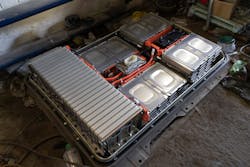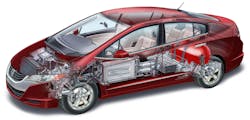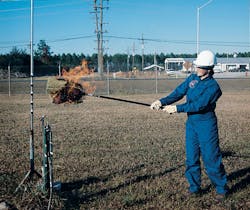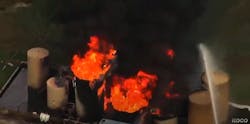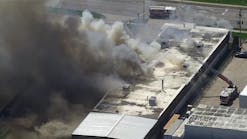Hazmatology: Handling Emergencies in Alternative Fuel Vehicles
According to the NFPA, there are at least 13 million alternative fuel vehicles on U.S. roadways today. All fuels of alternative fuel vehicles are hazardous to one degree or another. Given the trend toward increased use of these vehicles, responders must be prepared to deal with these fuels on the scene of vehicle accidents.
Fuels other than gasoline
Historically, vehicles have been powered by petroleum-based fuels, including gasoline and diesel fuel. In recent years, the use of ethyl alcohol, or ethanol, as a blended fuel with gasoline increased in use. Other fuels that are gaining in use are hydrogen, natural gas, propane and electricity. Each has its own hazards that might affect responders during an emergency that involves vehicle accidents.
Often, fire is involved in gasoline- and diesel-fuel-powered vehicle accidents, and water, foam and dry chemicals commonly are used to extinguish these fires. Ethanol requires the use of alternative foams.
As gases, hydrogen, natural gas and propane present new challenges to emergency responders. (Natural gas and propane are quite common in transportation and fixed-facility incidents.) Because responders to vehicle accidents rarely encounter hydrogen, they might be unfamiliar with its properties and how to deal with it. Thus, it is important to determine what type of fuel might be spilled, leaked or on fire as the result of a vehicle accident.
Ethanol
Ethanol is a Class 3 Flammable Liquid. Large-scale manufacture and use of ethanol as a motor fuel in passenger and other highway vehicles increased over the past decade. Ethanol is flammable and toxic to some degree.
Because water and alcohols are polar compounds, they are miscible. That is to say, they mix when placed together. This is one of the reasons that different types of firefighting foam are required for alcohol fires compared with gasoline or diesel fuel fires.
If spilled in a water source, ethanol is difficult to clean up, and its wide flammable range (3.3 percent–19.0 percent) means that it burns within a greater percentage of mixtures of fuel and air than gasoline and diesel fuel do.
Ethanol might be encountered in different mixtures with gasoline. Mixtures in which ethanol is a small percentage (10 percent–15 percent) can be treated as any other gasoline fire or spill. However, when the mixture is 85 percent ethanol and 15 percent gasoline, fires and spills must be treated as an alcohol incident.
Another different physical characteristic between ethanol and gasoline and diesel fuel is the color of the flame. Gasoline and diesel fuel burn with a yellow/orange flame. Ethanol burns with a bluish flame that might be difficult to view in certain lighting. Ethanol fires also give off less carbon or black smoke than gasoline and diesel fuel fires do. That said, ethanol fires can be extinguished with dry chemical fire extinguishers.
Gasoline, diesel fuel and ethanol are much easier to deal with than gases. Liquids generally can be seen in a leak or spill. Gases might be odorless, colorless and invisible to the eye, and in a leak situation, monitoring instruments are necessary to determine whether there is a leak and the levels of gas that are present. Furthermore, gases are stored in low-pressure or high-pressure tanks in vehicles. When subject to flame impingement, these tanks can fail explosively. When a gas leak reaches an ignition source and burns, it might be better to let the fire burn, so you know where the gas is—as long as the fire is not impinging on the tank.
Propane
Because propane, or liquefied petroleum gas (LPG), vehicles (passenger cars, pickups, farm tractors, taxis, school buses and heavy-duty trucks) have been in use for decades, there are thousands of propane fueling stations in the United States. On a vehicle, propane is stored as a liquid in a pressure tank, usually at the rear of the vehicle.
There are two types of propane vehicles: dedicated and bi-fuel. Dedicated propane vehicles run only on propane. Bi-fuel vehicles’ two separate fueling systems enable the vehicles to run on either propane or gasoline and typically provide a greater range than dedicated propane or gasoline vehicles. Of course, multiple fuel tanks are a matter for responders at an accident to consider.
Propane is a gas at atmospheric pressure and normal ambient temperatures. (It can be liquefied.) Normally, foul-smelling ethyl mercaptan is added as an odorizer to propane, so leaks can be detected easily. Furthermore, it’s possible to detect the escape of propane, because vaporization forms a whitish fog. When mixed with air, propane gas can burn or explode when it meets a source of ignition. Propane is heavier than air, so it tends to sink toward the ground and can flow for a long distance and collect in low-lying areas.
Propane is highly flammable. It has a flash point of -156 degrees F. Its auto-ignition temperature has a range of 842 degrees F–1,020 degrees F. It has a lower explosive limit (LEL) of 2.1 percent and an upper explosive limit (UEL) of 9.5 percent. (Note: The physical characteristics of propane can vary based on mixture and manufacturer. Furthermore, information on combustion factors of flammable liquids and gases isn’t an exact science, given the many variables that play into their calculation. At the end of the day, they are meant to provide a temperature or range to determine when responders are in a danger zone and what temperatures of ignition sources should be watched for. The only way to produce exact figures is to know who made the product.)
Fire extinguishing agents include CO₂, dry chemical powder and water spray. During a fire, if tanks are exposed to the fire or to heat, they should be kept cool by spraying water if they are exposed to fire or heat. If not cooled sufficiently, tanks will explode in fire.
Natural gas
Natural gas won’t burn unless the mixture is within a flammable range of roughly 4 percent–15 percent gas per volume of air. A combustible mixture of natural gas and air also has a very high ignition temperature. Furthermore, because natural gas is lighter than air, it can dissipate into the air rapidly, which makes accidental combustion difficult. Natural gas is colorless, nontoxic and has no taste in its natural state, and when it’s taken from the ground, it is odorless. As with propane, mercaptan is added to make leaks easy to detect.
Various sources peg natural gas’ ignition temperature at 1,076 degrees F to 1,170 degrees F. In any case, that is almost twice the ignition temperature for gasoline.
The most effective way to extinguish a natural gas-fueled fire is by using dry chemical and gas extinguishing agents.Hydrogen
Only a few hydrogen fuel cell vehicle models are for sale or lease, and availability is limited to areas that have hydrogen fueling stations, mostly in California.
At standard temperature and pressure, hydrogen is a colorless, odorless, tasteless, nontoxic, nonmetallic, highly combustible gas. It is 14 times lighter than air. Hydrogen has a very wide flammable range and forms explosive mixtures with air in concentrations from 4 percent–75 percent. Explosive reactions might be triggered by spark, heat or sunlight. Hydrogen’s auto-ignition temperature is 997 degrees F. Pure hydrogen-oxygen flames emit ultraviolet light and with high oxygen mix are nearly invisible to the naked eye.
A burning hydrogen leak can be very dangerous. Such a leak might require a flame detector. Approaching a potential flaming hydrogen leak also can be done with a straw broom extended in front of responders. The broom will catch fire when it encounters an invisible hydrogen flame. Hydrogen poses a number of hazards to responder safety, from potential detonations and fires when mixed with air, to being an asphyxiant in its pure, oxygen-free form.
If there is a fire, don’t extinguish it until the hydrogen supply is shut off, because unburned gaseous hydrogen can result in an explosion. The best way to handle a vehicle fire that involves hydrogen is to cool surrounding surfaces and let the fire burn itself out. This is better than extinguishing the fire, which might allow an uncontrolled leak to continue and possibly reignite when another ignition source is encountered.Electricity
According to FEMA, there are at least 1 million electric and plug-in automobiles on U.S. roads. The batteries that are used in these vehicles have special safety concerns for first responders if there is a vehicle fire. Electric vehicle fires can exceed 5,000 degrees F. Applying water or foam might cause a violent flare-up, as the water molecules separate into explosive hydrogen and oxygen gases.
Risks for first responders to electric vehicle fires include electrical shock (up to 400 volts), toxic fumes, lithium burns (respiratory and skin reactions) and the potential for re-ignition for as long as 24 hours after initial extinguishment.
Firefighters should wear full PPE and SCBA and secure a large, continuous and sustainable water supply. Use a large volume of water, such as a master stream, a 2½-inch hoseline or multiple 1¾-inch hoselines to suppress and cool the fire and the battery.
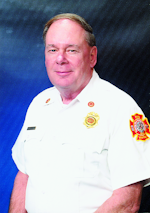
Robert Burke
Robert Burke, who is a hazardous materials and fire protection consultant and who served as a Firehouse contributing editor, is a Certified Fire Protection Specialist (CFSP), Fire Inspector II, Fire Inspector III, Fire Investigator and Hazardous Materials Specialist. He has served on state and county hazmat teams. Burke is the author of the textbooks "Hazardous Materials Chemistry for Emergency Responders," "Counter-Terrorism for Emergency Responders," "Fire Protection: Systems and Response," "Hazmat Teams Across America" and "Hazmatology: The Science of Hazardous Materials."
